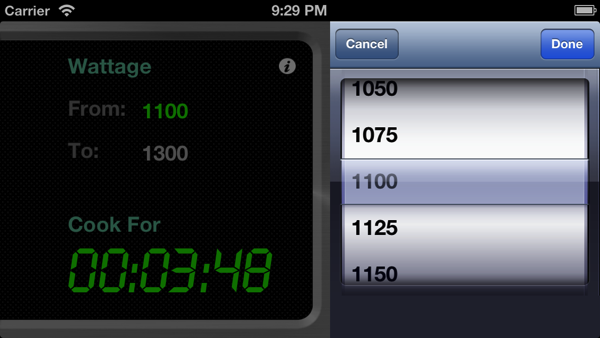Watt Time Is It?
No, that’s not a typo!
I’m happy to announce that Visoft, Inc. has released our first iOS application, WattTimeIsIt.
WattTimeIsIt is a simple application that allows you to figure out the time needed to cook something in the microwave based on the wattage. Take a microwavable dinner package that states “Microwave on HIGH for 4-5 minutes,” but in little print you see: “Microwave oven time based on an 1100W microwave.” That’s fine, but if you have a 1300W microwave, you will overcook your food based on those directions. If you have a 700W microwave, you will undercook your food. Overcooked food is miserable to eat, if you even have the opportunity. Lots of times things will boil over and spill out of the container when they are cooked too long. Of course, I suppose that’s better than undercooked food, which can be extremely dangerous.
What are you to do? Now there’s a simple solution. Simply ask “WattTimeIsIt?” and you’re all set!
Below is a screenshot of WattTimeIsIt in action.

Did you get the hidden “homage” in that screenshot?
Features
WattTimeIsIt supports iOS 5.0 and above (tested up to 6.1.4) and is designed with the iPhone 5′s 4″ screen in mind. Changing the default wattage is simple. Just click on the wattage number (e.g. 1100 in the screenshot below; note that it is highlighted) and that will pop up a wattage selector.

When you change the wattage, it will update the time. The wattages are saved so you don’t always have to change them every time you use the application.
RubyMotion FTW
Let’s talk a little about WattTimeIsIt’s development. Of course iOS applications are coded in Objective-C, right? Well, not all of them! There are various approaches that you can take. Given my love of Ruby, I discovered and fell in love with RubyMotion. RubyMotion has turned iOS development into something of a dream. Before I continue, you should be aware that RubyMotion is a paid product. That said, the joy of coding in Ruby makes it worth the price of admission. In addition there are tons of open-source libraries and wrappers available for RubyMotion, which I’ll get to in a minute. The RubyMotion community has simply been awesome.
RubyMotion by itself is great, but what makes it even better are those libraries and wrappers. I specifically loved working with teacup, sugarcube, and sweettea. Teacup is a DSL for laying out iOS interfaces. You can sort of think of it as “CSS for iOS apps,” though that doesn’t really do it justice. Sugarcube makes working with Cocoa APIs so much easier, giving it Ruby-like syntactic sugar. Last but not least, there is sweettea. What do you get when you mix sugarcube with teacup? Well, sweettea of course! Sweettea takes the syntactic sugar of sugarcube and brings even more enhancements to layouts in teacup. These are just three examples of the many libraries and wrappers for RubyMotion.
Remember I said earlier that the community around RubyMotion is awesome? Well, here’s just one example. The author of the libraries listed above, @colinta seems to always be available to lend a hand to iOS developers, e.g. he’s constantly on the #rubymotion IRC channel on freenode just waiting to help.
So Watt Time Is It?
Time to head over to the App Store and check out the app! We’d be interested to know what enhancements you’d like to see in the future. Be sure to contact us with your ideas. You can find us on Twitter, @visoft, Facebook, and of course our website, where you can contact us directly.

